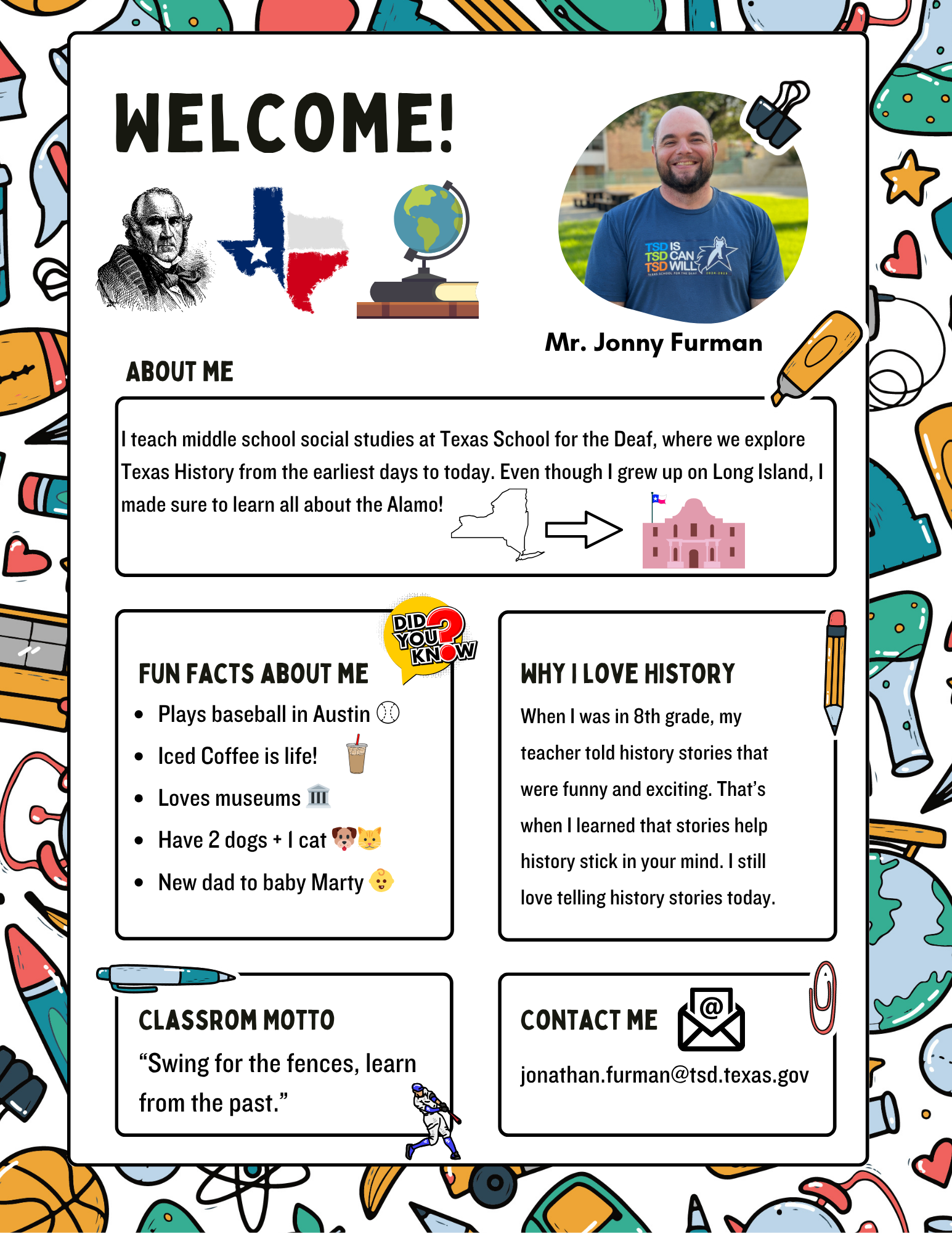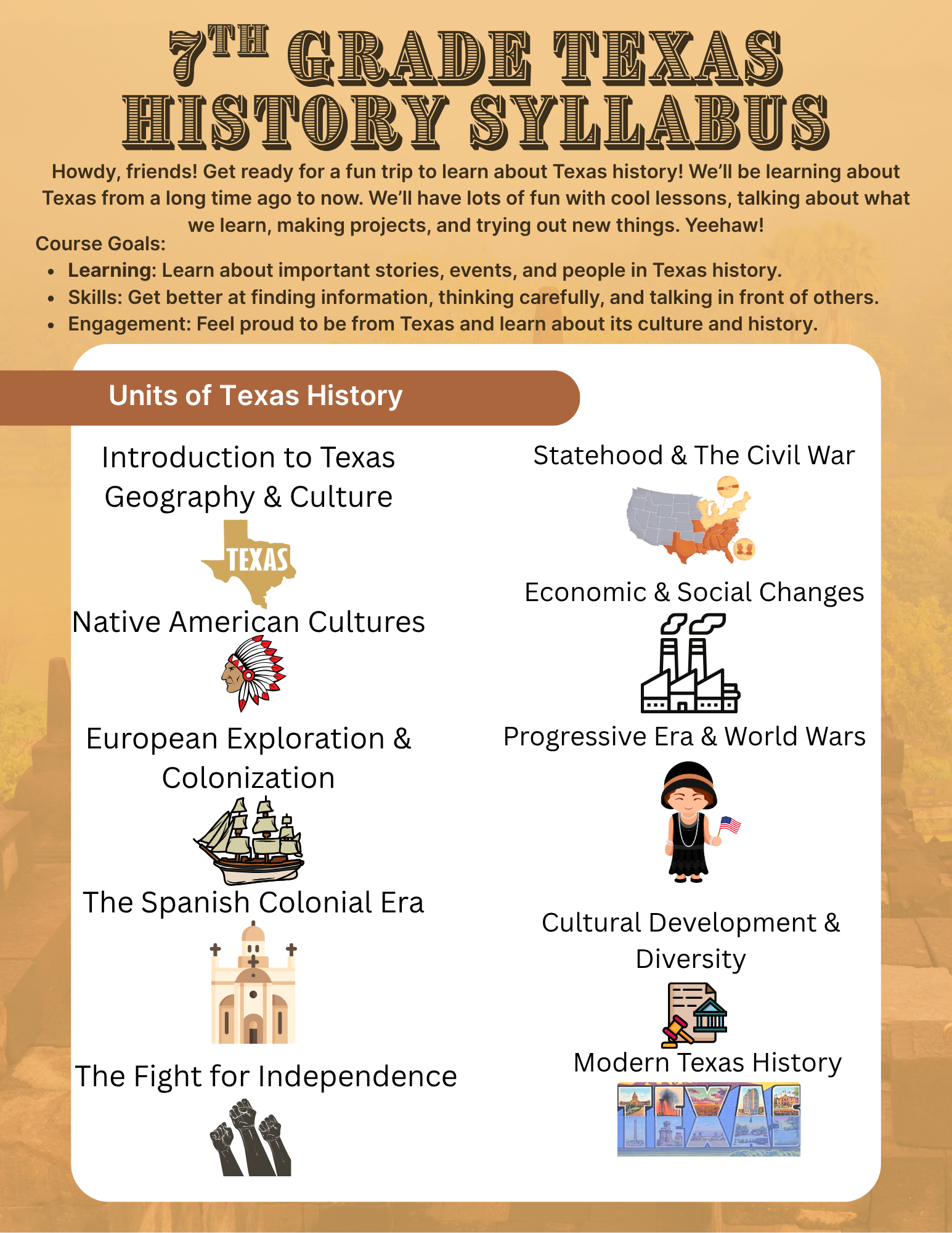Welcome to Mr. Furman's Page
How Parents Can Help at Home: Introduction to Texas Geography & Culture
You can help your child prepare for our unit on Introduction to Texas Geography & Culture by exploring maps, landscapes, and traditions that make Texas unique.
-
Explore Texas Regions: Look at maps showing the four major geographic regions of Texas—Mountains & Basins, Great Plains, North Central Plains, and Coastal Plains. Discuss the climate, landforms, and natural resources in each.
-
Connect Geography to Life: Talk about how climate and geography influence jobs, transportation, and daily life in different parts of the state.
-
Highlight Cultural Diversity: Share traditions, foods, music, or celebrations from your own heritage or from different Texas communities.
-
Make Local Connections: Identify which Texas region your family lives in and how its features shape your local community.
By connecting geography and culture at home, you can help your child see how the land and the people together create the story of Texas.
How Parents Can Help at Home: Native American Cultures
You can help your child prepare for our unit on Native American Cultures by encouraging learning beyond the classroom.
-
Learn About Tribes: Explore maps and resources showing where different Indigenous tribes of Texas and North America lived. Discuss how geography shaped their way of life.
-
Share Stories & Traditions: Read legends, watch documentaries, or visit museum exhibits about Native American history and culture.
-
Highlight Contributions: Talk about Native American innovations in farming, architecture, language, and government that still influence us today.
-
Respect & Perspective: Encourage your child to think about how Native American cultures have been preserved, adapted, or challenged over time.
Even brief conversations or activities at home can help students connect personally with the history and contributions of Indigenous peoples.
How Parents Can Help at Home: European Exploration & Colonization
You can help your child prepare for our unit on European Exploration & Colonization by connecting classroom learning to real-world understanding.
-
Map the Routes: Look at maps showing Spanish and French exploration in Texas and North America. Discuss why explorers traveled certain routes and what they hoped to find.
-
Explore Early Life: Talk about what life may have been like in missions, presidios, and early settlements—compare it to life today.
-
Visit Historical Sites: If possible, visit a local mission, presidio, or reconstructed settlement to see history firsthand.
-
Discuss Cultural Exchange: Explore how European settlers and Native Americans influenced each other’s food, language, and traditions—both positive and negative.
Short discussions, shared readings, or visits to historical locations can help your child better understand the challenges and impacts of early European settlement in Texas.
How Parents Can Help at Home: The Spanish Colonial Era
You can help your child prepare for our unit on The Spanish Colonial Era by making connections between history and daily life.
-
Explore Daily Life: Discuss what daily routines might have been like for people living in Spanish Texas—ranching, farming, trade, and religion.
-
Understand Colonization’s Impact: Talk about how Spanish colonization affected Native populations, including cultural blending, displacement, and changes in land use.
-
Visit or Research Missions: Explore a local mission (in person or online) to see the architecture, layout, and purpose of these sites.
-
Connect to Modern Texas: Identify Spanish influences still present today—place names, foods, architecture, and celebrations.
By linking past and present, you can help your child see how the Spanish Colonial Era shaped Texas’s identity and the lives of its people.
How Parents Can Help at Home: The Fight for Independence
You can help your child prepare for our unit on The Fight for Independence by encouraging curiosity about the people and events that shaped Texas.
-
Discuss the Causes: Talk about why tensions grew between Texian settlers and the Mexican government, including laws, land rights, and cultural differences.
-
Learn the Key Events: Review significant moments of the Texas Revolution—Gonzales, the Alamo, Goliad, and San Jacinto—and why each was important.
-
Meet the Leaders: Explore the lives of figures like Sam Houston, Stephen F. Austin, and others who influenced the fight for independence.
-
Visit Historical Sites: If possible, visit a Texas Revolution battlefield, museum, or monument to see artifacts and stories firsthand.
Brief conversations, storytelling, or visiting historical locations can help your child see how the fight for Texas independence was about more than battles—it was about shaping a new identity.
How Parents Can Help at Home: The Republic of Texas
You can help your child prepare for our unit on The Republic of Texas by exploring the challenges and achievements of Texas as an independent nation.
-
Understand the Challenges: Discuss the problems the Republic faced—debt, defense, diplomacy, and relations with Native tribes.
-
Learn About the Leaders: Explore the presidencies of Sam Houston, Mirabeau B. Lamar, and Anson Jones, and how their policies shaped the young nation.
-
Connect to Modern Texas: Talk about how decisions made during this period still influence Texas today.
-
Explore Historical Documents: Look at maps, treaties, or proclamations from the Republic era to understand how leaders planned for growth and stability.
By connecting home discussions to classroom learning, you can help your child see how the Republic of Texas set the stage for statehood and shaped Texas’s identity.
How Parents Can Help at Home: Annexation & Statehood
You can help your child prepare for our unit on Annexation & Statehood by discussing how Texas transitioned from an independent republic to a U.S. state.
-
Review the Debate: Talk about why some Texans and Americans supported annexation while others opposed it, including issues of slavery, security, and economics.
-
Understand the Process: Explore how the U.S. Congress and Texas leaders negotiated the terms of statehood.
-
Connect to the Bigger Picture: Discuss how annexation fit into the broader story of U.S. expansion and its impact on Mexico.
-
Look for Lasting Impacts: Identify how statehood changed Texas’s government, laws, and relationship with other states.
By exploring these topics at home, you can help your child understand how joining the United States reshaped Texas’s future.
How Parents Can Help at Home: Civil War & Reconstruction in Texas
You can help your child prepare for our unit on Civil War & Reconstruction in Texas by connecting the events in Texas to the larger story of U.S. history.
-
Understand the Causes: Discuss why Texas joined the Confederacy, including issues of states’ rights, slavery, and economic concerns.
-
Explore the War’s Impact: Talk about how the Civil War affected daily life in Texas—economy, families, and communities.
-
Learn About Reconstruction: Review how Texas was readmitted to the Union and how Reconstruction policies affected political, social, and economic life.
-
Highlight Key Figures: Explore the roles of leaders, soldiers, and everyday Texans during this period.
By discussing these events at home, you can help your child see how the Civil War and Reconstruction shaped Texas’s path forward and left a lasting legacy.
How Parents Can Help at Home: Progressive Era & World Wars
You can help your child prepare for our unit on Progressive Era & World Wars by connecting classroom lessons to real-world examples and family history.
-
Explore the Progressive Era: Discuss reforms that aimed to improve working conditions, expand voting rights, and address social issues. Relate these to changes your child sees in their community today.
-
Connect to Texas’s Role in the Wars: Talk about how Texans contributed to World War I and World War II—serving in the military, producing goods, and supporting the war effort at home.
-
Highlight the Home Front: Explore how rationing, new jobs, and shifting roles affected Texas families during wartime.
-
Share Family Stories: If you have relatives who lived during these eras, share their experiences or photos to bring history to life.
By linking these topics to personal stories and local history, you can help your child see how reform movements and world events shaped Texas’s growth and identity.
How Parents Can Help at Home: Economic & Social Changes
You can help your child prepare for our unit on Economic & Social Changes by exploring how Texas transformed after the Civil War.
-
Discuss Agriculture & Industry: Talk about how farming, ranching, and new industries like oil shaped the Texas economy.
-
Follow the Railroads: Look at maps showing how railroads expanded across Texas and connected towns, boosting trade and travel.
-
Explore Urban Growth: Discuss why people moved from rural areas to growing cities and how modernization changed daily life.
-
Make Personal Connections: Share family stories, photographs, or artifacts from ancestors who lived during this era, if available.
These conversations help your child see how Texas’s economy and society evolved, laying the groundwork for the state we know today.
How Parents Can Help at Home: Cultural Development & Diversity
You can help your child prepare for our unit on Cultural Development & Diversity by exploring how the arts and diverse cultures have shaped Texas’s identity.
-
Explore Texas Music & Literature: Listen to country, Tejano, blues, or conjunto music, and read works by Texas authors. Discuss how these reflect Texas history and culture.
-
Appreciate Visual Arts & Architecture: Look at paintings, sculptures, and buildings influenced by Spanish, Mexican, German, Czech, African American, and Native American traditions.
-
Learn About Cultural Heritage: Share family traditions or research the customs, foods, and celebrations of various communities in Texas.
-
Connect to Today: Talk about how cultural diversity continues to influence Texas’s economy, politics, and communities.
These activities support TEKS goals of recognizing contributions of individuals and groups to Texas history, culture, and identity.
How Parents Can Help at Home: Modern Texas History
You can help your child prepare for our unit on Modern Texas History by connecting past events to current issues and achievements.
-
Review Major Events: Discuss important political, economic, and social events in Texas during the 20th and 21st centuries, such as the oil boom, the space program, and natural disasters.
-
Understand Contemporary Challenges: Talk about current topics in Texas like population growth, energy, technology, and environmental concerns.
-
Highlight Achievements: Explore Texas’s role in innovation, sports, the arts, and national leadership.
-
Make Local Connections: Relate state events to changes in your own community and how they’ve affected daily life.
By linking historic milestones with present-day Texas, you can help your child see how the past continues to shape the state’s identity and future.



